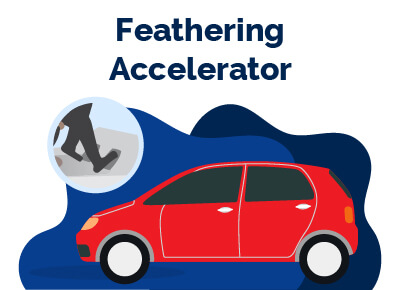All You Need To Know About Feathering The Accelerator
July 20, 2023


Chris is Head of Content for FindTheBestCarPrice and is based out of Philadelphia, PA. As a seasoned automotive industry analyst and car enthusiast, he ensures the highest level of quality across all our content and curates our picks for the best deals each month.
Chris studied information systems and marketing at Drexel University and writes about a wide range of topics ranging from car buying tips to troubleshooting common mechanical issues.
When he’s not thinking about cars, he likes to stay in with his dog and make an “attempt” to finish a crossword puzzle (he’s not quite at the Saturday/Sunday level…yet). As a former cheesemonger, Chris still has a “sharp” passion for all things cheese, and his fridge is always loaded with it!
Chris also has a passion for things that go fast, and drones are no exception. He spends some of his time writing for Dronesourced.
Employing the technique of feathering the accelerator is a proficient method to enhance the longevity of your car's brakes and engine while simultaneously augmenting fuel efficiency.
This driving technique necessitates utilizing a partial throttle while driving at a consistent pace, such as on a motorway or during traffic congestion.
A diverse range of driving techniques can be utilized to enhance fuel efficiency or maximize engine performance, contingent upon the desired outcome. One such technique that is frequently discussed is feathering the accelerator.
Therefore, what precisely does this technique entail, and how can you apply it to enhance your driving experience? Essentially, feathering the accelerator involves delicately pressing the gas pedal.
This technique can be especially beneficial when you aim to maintain a consistent speed or conserve fuel.
Let's delve deeper into this driving strategy!
Table of Contents
What Does Feathering the Accelerator Mean?
Feathering the accelerator is a driving maneuver that necessitates delicately manipulating the throttle to achieve a harmonious speed equilibrium, facilitating a smooth driving experience.
Feathering refers to the technique of exerting minimal pressure on the pedals to maintain speed while conserving fuel, in contrast to the extensive gas consumption that would result from entirely depressing the pedals.
The purpose of this technique is to minimize fuel consumption and diminish emissions by gradually accelerating through each gear rather than administering a substantial amount of fuel into the engine all at once.
This technique involves a careful balance of power and restraint, which can ultimately result in significant fuel savings and reduced environmental impact.
How To Feather the Accelerator
Typically, as you increase your engine's RPM, the engine control unit injects more fuel into the combustion chamber to maintain performance and throttle response. However, when you apply gentle pressure to the accelerator, the fuel injection rate is reduced.
This method of acceleration results in a performance proportional to the pressure applied, meaning that you won't accelerate as rapidly as you would by fully depressing the throttle.
Therefore, feathering the throttle allows for a more relaxed driving experience while providing a range of advantages when executed correctly.
Advantages of Feathering the Accelerator
Feathering the accelerator is an essential technique as it significantly mitigates the wear and tear on your vehicle.
Consequently, the vehicle is expected to have a prolonged lifespan, translating to substantial long-term cost savings.
If you engage in frequent driving activities, procuring a fuel-efficient vehicle that can proficiently transport you to your desired destination without encountering mechanical failures en route would be prudent.
Notably, feathering the accelerator contributes to fuel conservation by enabling a seamless acceleration process, reducing fuel wastage during zero-speed or uphill acceleration.
Moreover, this approach positively impacts the environment, as it curtails emissions to a considerable extent. These are other advantages:
1. It Improves Fuel Efficiency.
Employing the technique of feathering the accelerator drastically curtails fuel consumption.
This technique necessitates minutely reducing the speed of your vehicle, which, in turn, enables the engine to maintain a consistent speed without requiring excessive fuel.
This approach ultimately reduces fuel consumption, resulting in a proportional decrease in CO2 emissions while contributing to cost savings on gas.
2. It Extends the Life of your Engine.
Feathering the accelerator is a commendable approach that significantly prolongs engine life by reducing wear and tear.
This technique necessitates delicately manipulating the accelerator pedal to apply minimal pressure, which results in only a slight increase in engine speed.
Consequently, this approach impedes the engine from working excessively, preventing premature wear and tear.
3. It Reduces Wear and Tear on the Brake Pads and Rotors.
The engine functions as the principal source of power for your vehicle. During the descent of a hill, implementing the feathering technique or lifting your foot off the accelerator aids in maintaining a steady pace while simultaneously preventing undue strain on the brake pads and rotors.
In manual transmission vehicles, feathering entails delicately depressing and releasing the clutch pedal while retaining a firm grip.
4. Feathering the Accelerator Helps When You Want To Park or Reverse.
When operating a manual transmission automobile, utilizing the feathering technique can prove advantageous.
This approach eliminates the need for repetitively engaging and releasing the clutch while minimally depressing the accelerator pedal, allowing a smooth transition into reverse without jarring movements.
Upon mastering this technique, executing a gradual reverse movement with consistent accelerator pressure becomes more effortless.
Additionally, this technique facilitates the parking process, eradicating the possibility of damaging the clutch through the consistent application of the pedal and acceleration.
5. Smooth Highway Driving.
Feathering the accelerator proves most effective when driving on highways. When confronted with lengthy stretches of road, the optimal approach is to leisurely traverse it, applying delicate pressure to the accelerator pedal and gradually escalating the speed.
This technique simulates the function of cruise control systems, albeit with increased safety for automobiles lacking adaptive cruise control systems or speed boost capabilities.
By implementing this approach, one can steadily accelerate as needed, ensuring optimal speed and fuel consumption in diverse driving scenarios.
Best Time for Feathering the Accelerator
1. Driving in Traffic
Feathering the accelerator is particularly advantageous when navigating heavy traffic. This involves delicately pressing and releasing the gas pedal instead of forcefully depressing it.
Doing so lets you anticipate and provide the necessary power your car requires. Consequently, you can have more comprehensive command over your vehicle, thus easing congestion and promoting a more orderly traffic flow.
In congested thoroughfares, particularly when executing turns or negotiating junctions, feathering the accelerator can give the driver a sense of control.
Moreover, releasing the pedal gently instead of abruptly stepping on the brake can facilitate rapid deceleration.
2. When Driving on the Motorways
Feathering the accelerator is an efficacious driving technique when maintaining a constant pace on highways and other swift a roads.
It eliminates sluggishness when shifting lanes or moving away from intersections, except when many vehicles are trailing behind.
Moreover, this method guarantees that the engine doesn't undergo overheating, as it operates moderately while stationary at traffic signals or while waiting for an obstruction to clear before resuming acceleration.
3. When Driving at Constant Speeds
The feathering technique is a highly effective driving method for cruising at constant velocities on the motorway. It's comparatively stress-free and has the added benefit of mitigating fuel expenditure.
Feathering, in essence, refers to the gradual acceleration of your car to a speed within the range of 40-65mph (64-105km/h), which is then followed by a gradual release of pressure on the accelerator pedal until the speed returns to around 40mph (64km/h).
As a result, the engine speed reduces slightly with each easing of pressure on the pedal.
When To Avoid Feathering the Accelerator
Despite the multitude of advantages of feathering the accelerator, there are certain situations where there may be better options.
For example, overtaking can only be accomplished by applying gentle pressure to the accelerator pedal, or at least not without compromising safety.
Overtaking requires precision and speed, with the driver ahead being signaled so that everyone knows your intentions. If the overtaking maneuver takes too long, a head-on collision with an oncoming vehicle is likely.
Even on a highway, quick overtaking is necessary since other drivers may be traveling at a much higher speed in the "fast" lane.
As such, it is essential to overtake as quickly and safely as possible before returning to your lane, after which feathering the throttle can be resumed.
Feathering the accelerator is also not recommended when merging onto a highway, as other vehicles on the road may travel much faster than you.
Best Car Deals by Category
Frequently Asked Questions
Can feathering the accelerator causes damage to the engine or transmission?
Feathering the accelerator does not cause any damage to the engine or transmission as long as you do it properly. However, using this technique excessively or inappropriately can cause excessive wear and tear on the engine or transmission, leading to premature failure or breakdowns.
Is feathering the accelerator the same as using cruise control?
No, feathering the accelerator is not the same as using cruise control. Cruise control is a system that automatically maintains a constant speed without requiring the driver to use the gas pedal. Feathering the accelerator requires the driver to apply and release pressure on the gas pedal to maintain a constant speed.
Can feathering the accelerator help reduce brake wear?
Yes, feathering the accelerator can help reduce brake wear because it allows you to maintain a constant speed without needing to apply the brakes excessively. This technique is advantageous when driving in traffic or descending hills, where excessive braking can cause premature wear and tear on the brake pads and rotors.
Posted in Car Buying Tips, Car Troubleshooting |




